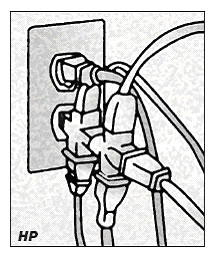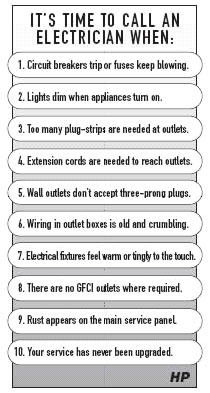| |
| Here’s what to look for: |
| 1. “System Interruptus” puts you in the dark. If electrical circuit-breakers trip often, or fuses blow frequently, your circuits are drawing more current than they can safely provide. This may also indicate a dangerous fault on one or more circuits. |
| |
2. The lights flicker and wane. Does your hair dryer give the vanity lamp a moment’s pause? When the fridge or air conditioner comes on, do the ceiling lights dim? Many motor-driven appliances draw lots of current and should be wired on dedicated circuits. If smaller appliances also cause problems, consider adding a 20-amp line to service them.
|
| |
3. There’s an octopus at many outlets. If plug-strips and multi-receptacle addons are strangling your outlets, your electrical system is working beyond capacity. Additional circuits with duplex receptacles are needed to restore order— and safety.
|
| |
| 4. Rug bumps mess up the carpet. If your living room looks like a snake farm with wires running under the rugs and furniture, a dangerous condition exists, and you definitely need more outlets. If some of those wires are extension cords, the outlets you have are too far apart. Both signs usually indicate that additional outlets are required throughout the house. |
| |
| 5. Three into two won’t go. Many older homes have outlets that won’t accept three-prong grounded plugs. This is a bigger problem than not being able to plug in the microwave oven—it could indicate that your electrical wiring system is not fully grounded, and you’re not completely safe. |
| |
| 6. The old standards just don’t apply. When you remove an outlet or switch cover, do you find bits of black rubber in the box? Are the wires covered in cloth instead of plastic? If you have an older home and the answers are yes, it means the insulation on the wires is antiquated and dangerously deficient for today’s electrical needs. |
| |
7. You get a warm, tingly feeling all over. Are outlets, switches or other electrical- system surfaces warm to the touch? Do you see any blackening nearby on the switchplate or wall, switch terminals or wire ends? Does a switch or outlet give a mild shock? The problem could simply be too much demand on the circuit, or something far more complicated and dangerous. If your home was built or wired during the period from 1965 to 1975, it may even have aluminum wiring. If it does, have it checked regularly.
|
| |
| 8. It’s not safe to go near the water. Wet locations such as kitchens, baths and utility rooms, as well as grounded areas like your basement or garage, now require outlets protected by Ground Fault Circuit Interrupters, or GFCIs. Easy retrofit installation will make your home code-compliant—and safe. If GFCIs have already been installed near sinks and dishwashers, test their reset buttons to be sure they’re working properly. |
| |
9. Rust is slowly taking over. If you begin to notice rust or moisture on or under your home’s main service panel, it’s a sign that something’s going wrong. Deterioration at the panel threatens the main wiring connections within, and could indicate similar problems throughout your electrical system.
|
| |
| 10. It’s not getting better—just older. If your home is more than 25 years old, and you’ve never upgraded your electrical service, you may be living with an inadequate and possibly hazardous wiring system. For your family’s safety and your own peace of mind, have an electrician inspect it and, if necessary, bring it up to today’s code standards. |
| |






